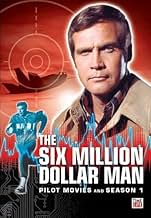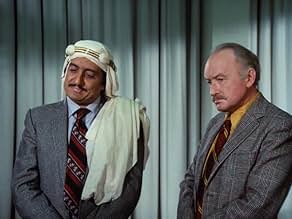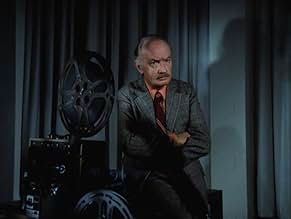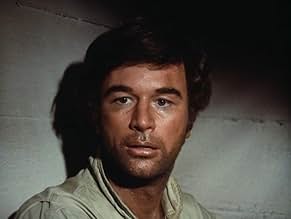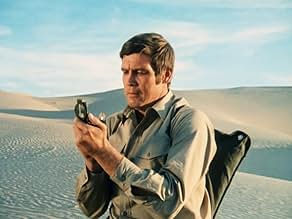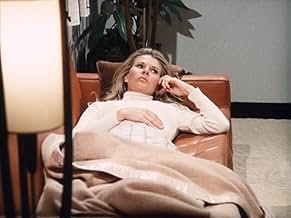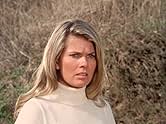Der sechs Millionen Dollar Mann
Originaltitel: The Six Million Dollar Man
IMDb-BEWERTUNG
6,9/10
5409
IHRE BEWERTUNG
Füge eine Handlung in deiner Sprache hinzuAfter an astronaut and test pilot is catastrophically mutilated in a test plane crash, he is rebuilt and equipped with nuclear powered bionic limbs and implants.After an astronaut and test pilot is catastrophically mutilated in a test plane crash, he is rebuilt and equipped with nuclear powered bionic limbs and implants.After an astronaut and test pilot is catastrophically mutilated in a test plane crash, he is rebuilt and equipped with nuclear powered bionic limbs and implants.
- Auszeichnungen
- 1 Nominierung insgesamt
Charles Robinson
- Prisoner
- (as Charles Knox Robinson)
George D. Wallace
- General
- (as George Wallace)
Olan Soule
- Saltillo
- (as Olan Soulé)
Claire Brennen
- OSI Committee Member
- (Nicht genannt)
Eddie Garrett
- Security Guard outside Steve's room
- (Nicht genannt)
Empfohlene Bewertungen
Even it didn't introduction one of the most iconic fictional characters of all time this would stand up as a great movie. However, since it does introduce Steve Austin (one of TV's best-ever characters and greatest superheroes), this raises it up to be something truly special. Watching it is something akin to a spiritual experience. Trying to write an impartial review is next to impossible, since I love every second of this thing with passion. But I'll have a go.
Tight pace. The opening minutes show two men in parallel: a pilot called Steve Austin who is about to test a new type of plane, and very serious government official who is proposing a new type of soldier/spy to a room of very stuffy and self-important people. As we move into the second quarter of the movie, Austin has been mutilated in a crash and is being kept alive by machines. His suffering is succinctly brought across in several short/ingenious scenes. The mid-section of the movie shows us the new Austin: rebuilt by science and trying to master his new limbs. By the time we enter the final quarter of the movie, Steve is fully in control of his new body parts and we see him start to use them: first to save a boy in a traffic accident, and then on his first mission.
Lee Majors. In one of the great marriages between character and actor, Majors takes the reins of Austin and makes him his own. Right from the first moment he saunters into shot Steve Austin is a likable hero: a very real, very human superhero. There are corny moments (like Steve addressing the entire flight crew by first name and seeming to know all about them) but Majors sells everything in the script. And adds to it. Two minutes into the movie, 50% of the guys watching will want to invite Austin for a few beers on the town and the other half will wish they were Austin. When the action gets dramatic (Austin trying to end his pathetic life, or - later - examining his own right arm) Majors is 100% committed to the role and he's make you feel everything Steve does.
Cleverness. The movie is clever, and subtle, in ways that the (wonderful) TV series never tried to be. The man who orders the rebuilding of Austin walks with a cane. He is also heartless and - because of this - is more of a robot than Austin will ever be. The storytelling is wonderfully subtle in other ways, too. As Austin is told of his accident, the camera cuts away and we see/hear the reaction of the heart monitor. The sound, I suppose, of a breaking heart. And, later in the story, as Austin is on the verge of giving that heart to the pretty young nurse that has fallen in love with him, the story takes another unexpected turn: Austin orders her off the case and she overhears. We expect that she will run away in tears. Instead, she confronts Austin and calmly states her case. She doesn't behave like a 'tv character', she behaves like a real woman. It's the character's best scene. Finally, the mission that Steve goes on is not quite what it appears to be. Clever scripting makes everything, and everyone, shades of grey and makes the entire story more enjoyable.
Casting. Darren McGavin almost steals the movie from Majors with a truly fascinating portrayal of the man who orders the rebuilding. Martin Balsam and Barbara Anderson round out the cast and each one gets scene after scene of quality material.
Continuity. The three movies that started the SMDM series are an oddity. None of them really fits in with the continuity of the series. (In a nice bit of symmetry, the three movies that ended the series are exactly the same: Part of the franchise, but not quite...) Cyborg has many elements that are exactly the same as the series. The character of Steve Austin is consistent, even if his rank/status within the Air Force is not the same. Rudy Wells, the doctor that saves Steve and makes him bionic is also exactly as you will find him in the television series. It's a different character, yes, but he has the same heart and intelligent. He has the same bond with Steve, too. But there are many elements that are not even close to the TV series. Instead of beloved Oscar Goldman, we get a hard-nosed bastard called Oliver Spencer calling the shots. This guy sees Steve as a weapon. Nothing more. In the episodes that followed, many scripts made it clear that there was a very strong bond/friendship between Steve and his so-called boss. Some episodes made them seem like partners working side-by-side, and most episodes made it clear that they loved one another as only best friends can. It's fascinating to see what direction the show could have taken. Fascinating, but not better. Then there is the lover. She disappears after this and is never mentioned again (though the series does introduce a similar character at one point). We can presume that Nurse Jean got over her infatuation and she and Steve called it quits. There are other things, too. Minor things, mostly, like the name of the OSI being something different. Things that mean, if you want to look at it this way, that the events of this story take place in a parallel universe.
Or something.
I don't care.
It's a superb movie. It captured my imagination when I first saw it, as a child, and it still has a firm grip on my imagination (and my heart) all these years later.
http://yetanothertvreviewpodcast.blogspot.com/
Tight pace. The opening minutes show two men in parallel: a pilot called Steve Austin who is about to test a new type of plane, and very serious government official who is proposing a new type of soldier/spy to a room of very stuffy and self-important people. As we move into the second quarter of the movie, Austin has been mutilated in a crash and is being kept alive by machines. His suffering is succinctly brought across in several short/ingenious scenes. The mid-section of the movie shows us the new Austin: rebuilt by science and trying to master his new limbs. By the time we enter the final quarter of the movie, Steve is fully in control of his new body parts and we see him start to use them: first to save a boy in a traffic accident, and then on his first mission.
Lee Majors. In one of the great marriages between character and actor, Majors takes the reins of Austin and makes him his own. Right from the first moment he saunters into shot Steve Austin is a likable hero: a very real, very human superhero. There are corny moments (like Steve addressing the entire flight crew by first name and seeming to know all about them) but Majors sells everything in the script. And adds to it. Two minutes into the movie, 50% of the guys watching will want to invite Austin for a few beers on the town and the other half will wish they were Austin. When the action gets dramatic (Austin trying to end his pathetic life, or - later - examining his own right arm) Majors is 100% committed to the role and he's make you feel everything Steve does.
Cleverness. The movie is clever, and subtle, in ways that the (wonderful) TV series never tried to be. The man who orders the rebuilding of Austin walks with a cane. He is also heartless and - because of this - is more of a robot than Austin will ever be. The storytelling is wonderfully subtle in other ways, too. As Austin is told of his accident, the camera cuts away and we see/hear the reaction of the heart monitor. The sound, I suppose, of a breaking heart. And, later in the story, as Austin is on the verge of giving that heart to the pretty young nurse that has fallen in love with him, the story takes another unexpected turn: Austin orders her off the case and she overhears. We expect that she will run away in tears. Instead, she confronts Austin and calmly states her case. She doesn't behave like a 'tv character', she behaves like a real woman. It's the character's best scene. Finally, the mission that Steve goes on is not quite what it appears to be. Clever scripting makes everything, and everyone, shades of grey and makes the entire story more enjoyable.
Casting. Darren McGavin almost steals the movie from Majors with a truly fascinating portrayal of the man who orders the rebuilding. Martin Balsam and Barbara Anderson round out the cast and each one gets scene after scene of quality material.
Continuity. The three movies that started the SMDM series are an oddity. None of them really fits in with the continuity of the series. (In a nice bit of symmetry, the three movies that ended the series are exactly the same: Part of the franchise, but not quite...) Cyborg has many elements that are exactly the same as the series. The character of Steve Austin is consistent, even if his rank/status within the Air Force is not the same. Rudy Wells, the doctor that saves Steve and makes him bionic is also exactly as you will find him in the television series. It's a different character, yes, but he has the same heart and intelligent. He has the same bond with Steve, too. But there are many elements that are not even close to the TV series. Instead of beloved Oscar Goldman, we get a hard-nosed bastard called Oliver Spencer calling the shots. This guy sees Steve as a weapon. Nothing more. In the episodes that followed, many scripts made it clear that there was a very strong bond/friendship between Steve and his so-called boss. Some episodes made them seem like partners working side-by-side, and most episodes made it clear that they loved one another as only best friends can. It's fascinating to see what direction the show could have taken. Fascinating, but not better. Then there is the lover. She disappears after this and is never mentioned again (though the series does introduce a similar character at one point). We can presume that Nurse Jean got over her infatuation and she and Steve called it quits. There are other things, too. Minor things, mostly, like the name of the OSI being something different. Things that mean, if you want to look at it this way, that the events of this story take place in a parallel universe.
Or something.
I don't care.
It's a superb movie. It captured my imagination when I first saw it, as a child, and it still has a firm grip on my imagination (and my heart) all these years later.
http://yetanothertvreviewpodcast.blogspot.com/
A very well done adaptation of Caidin's fine book, it has some interesting differences from the later show. Oscar Goldman, as played by Darrin McGavin is way more heartless and is intent on getting the governments worth out of Steve. Steve is much more mentally distressed and early on, suicidal after being maimed. It played more for adults, with an espionage theme (as did the second 90 minutes installment, Wine Women and War, with perenial bad guy Eric Braeden). It's very close to the book, but eliminates the female Israeli assigned to help Steve. It's very watchable even today and I wouldn't be surprised to see a big budget version get made.
The TV movie that led to "The Six Million Dollar Man" becoming one of the biggest hits of the 1970s, and being fondly remembered by many who were the right age at the time (not least me - I still remember playing with my Steve Austin doll), is strikingly different from what would come. Admittedly the series was hardly a laugh riot, but the source was even straighter, with nothing to indicate that Col. Austin would eventually acquire a bionic girlfriend (and dog) and meet the likes of Bigfoot, a double, and alien killer machines. (We won't mention that "Sweet Jaime" song.)
Not only does Henri Simoun's teleplay furnish our hero with some actual doubt over how much of a human being he is now, but the relationship between him and his superior officer is less chummy - no benevolent Oscar Goldman of the OSI here, instead the OSO's colder Spencer (Darren McGavin, easily taking the acting honours). Plus, when Steve is eventually sent into the field, it's surprisingly straightforward - the movie emphasises drama over derring-do (note the lack of DANANANANANANA sound effects). This isn't always for the best; the actual crash isn't as effective as it could have been, and 30 years on some elements have dated somewhat - who'd be so casual about a nuclear-powered motor today? - but if ultimately it's not as much fun as the series, it's also a bit more thoughtful.
Footnotes: This movie was edited into two parts and shown on the series as "The Moon And The Desert." More importantly, no one here calls him "a man barely alive," let alone says "We can rebuild him" or "We have the technology."
Not only does Henri Simoun's teleplay furnish our hero with some actual doubt over how much of a human being he is now, but the relationship between him and his superior officer is less chummy - no benevolent Oscar Goldman of the OSI here, instead the OSO's colder Spencer (Darren McGavin, easily taking the acting honours). Plus, when Steve is eventually sent into the field, it's surprisingly straightforward - the movie emphasises drama over derring-do (note the lack of DANANANANANANA sound effects). This isn't always for the best; the actual crash isn't as effective as it could have been, and 30 years on some elements have dated somewhat - who'd be so casual about a nuclear-powered motor today? - but if ultimately it's not as much fun as the series, it's also a bit more thoughtful.
Footnotes: This movie was edited into two parts and shown on the series as "The Moon And The Desert." More importantly, no one here calls him "a man barely alive," let alone says "We can rebuild him" or "We have the technology."
This is the first pilot of a five seasons series. The overall production values are satisfying enough to make the audience believe of that technological advancement miracle possible. This film is dry, raw, authentic, realistic, semi-documentary, existential and even depressing compared to the optimistic patriotic series thanks to the three actors' performance: Lee Majors, Martin Balsam and Darren McGavin. From the start, the character of Austin is defined: a rebel, a maverick, a dreamer, an individualistic test pilot who is a devotee of his past journey on the moon and doesn't follow the rules by the book -- he is late at his official appointment and replies sarcastically to a commanding officer -- Wells comments his attitude in this term: "Steve, you have a positive genius for antagonizing the wrong people". His best friend is, of course, Dr. Rudy Wells, a humanist, an innovator scientist-surgeon whose main concern is Austin's will to cope with his disability -- the name Wells may be a reference to utopist sci-fi writer H.G. Wells. The first waking up of Austin in Colorado's Research Center as an one-eyed, one-armed legless man, who tries to commit suicide during the night, is shocking, morbid and nightmarish -- it reminds me the bleakness of Dalton Trumbo's "Johnny Got his Gun". Austin is a self-conscious pragmatic man who wants to know the prize of his recovery: ruthless vulture ("I am not concerned by feelings"), cynical ("Accidents happen all the time. We just start from scrap"), mean ("Actually, we would prefer a robot -- 'robot' means a slave-worker in Czech --. A robot has no emotional need and responses. You're the optimun compromised"), crippled -- notice that he is also slightly disabled and walks with a stick -- O.S.O. head (scientifical department chief of the C.I.A.) Oliver Spencer sends him to his own death in the desert of Arabia on a suicidal mission where he receives another near fatal treatment. Spencer even asks Wells if he can let Austin in an indefinite artificial sleep until he needs him again. Austin refuses to be manipulated like a guinea pig, a "raw material" and reacts harshly: he slaps Spencer, turns down the hand of female Official Mrs. McKay and tells Spencer a curse before his forced electro sleep. The music of Gil Mellé is outstanding by creating the mood of technology, war and the character's psyche -- Austin is horrified by the view of his future artificial limbs, calls his friend Wells "Dr. Frankenstein, I presume?" after the bionic operation, he is uncomfortable with the ambiguity of the nurse's love impulse and feels monstrous owing to the woman's frightened behavior ("What are you?") after the rescue of her jeopardized son. The blend of experimental, distorted, atonal electronic style and a 1970's jazz helps the pace. Everything you want to know about Steve Austin lies in this rough pilot. Many episodes of the following series uses footages from that one and especially designer Jack Cole's main title. This is the work of Richard Irving who manages to produce and direct a clever adaptation of Martin Caidin's book. The film has an anti-government slant of that era via the Austin and Wells characters -- Austin's feeling about Spencer ("You're more of a robot than I am now") and Wells figure it out about Spencer's working plan for Austin in the Service: "Espionage, sabotage, assassination!" -- and, above all, the moral dilemma that is asked by the author of such advancement in the hands of the Power. There are subsequent themes tackled throughout the leading character: the loneliness and desperation, the inability to communicate, the fear of being abnormal and an outcast forever.
First TV movie pilot that introduced Lee Majors as Steve Austin, a former astronaut who had walked on the moon, but now is test piloting an experimental aircraft that unfortunately crashes, badly injuring Steve near death, but with the skill of brilliant surgeon Dr. Rudy Wells(played by Martin Balsam) and funding by secretive government representative Oliver Spencer(played by Darren McGavin) rebuild Austin with bionic limbs and sight, increasing his strength and survivability immensely, making him an ideal government operative, if he can only emotionally adjust to his new condition... Good setup to the eventual series has a smart, thoughtful script and good direction by Richard Irving. Pity this realistic style wasn't continued though...
Wusstest du schon
- WissenswertesDuring the opening sequence of the show, the crash shown is actual footage of a crash of the M2-F2 experimental lifting body that was part of the research that eventually led to the development of the space shuttle.
- PatzerThe "Factual Error" that Austin's human left arm should have been amputated to prevent incompatible balance produces an enormous character error if such had occurred. The friendship that is demonstrated between Austin and Dr. Wells would never allow the latter to amputate a healthy arm of his friend, whether it would be mechanically efficient or not. Further, Dr. Wells is portrayed as the kind of man not to violate his Hippocratic oath of "Do no harm" which such an amputation would be in contrast to.
- Zitate
Steve Austin: Yes sir?
General: Have you any idea what time it is?
Steve Austin: [looks up at the sky] About five to seven?
- Alternative VersionenRe-edited into two episodes of "The Six Million Dollar Man" for syndication. To pad out the story, scenes were added from Eine Partnerin für Steve (1975), The Bionic Boy (1976) and Dark Side of the Moon: Part 1 (1977).
- VerbindungenEdited from Verschollen im Pazifik (1970)
Top-Auswahl
Melde dich zum Bewerten an und greife auf die Watchlist für personalisierte Empfehlungen zu.
Details
- Laufzeit1 Stunde 15 Minuten
- Sound-Mix
- Seitenverhältnis
- 1.33 : 1
Zu dieser Seite beitragen
Bearbeitung vorschlagen oder fehlenden Inhalt hinzufügen

Oberste Lücke
By what name was Der sechs Millionen Dollar Mann (1973) officially released in Canada in English?
Antwort
